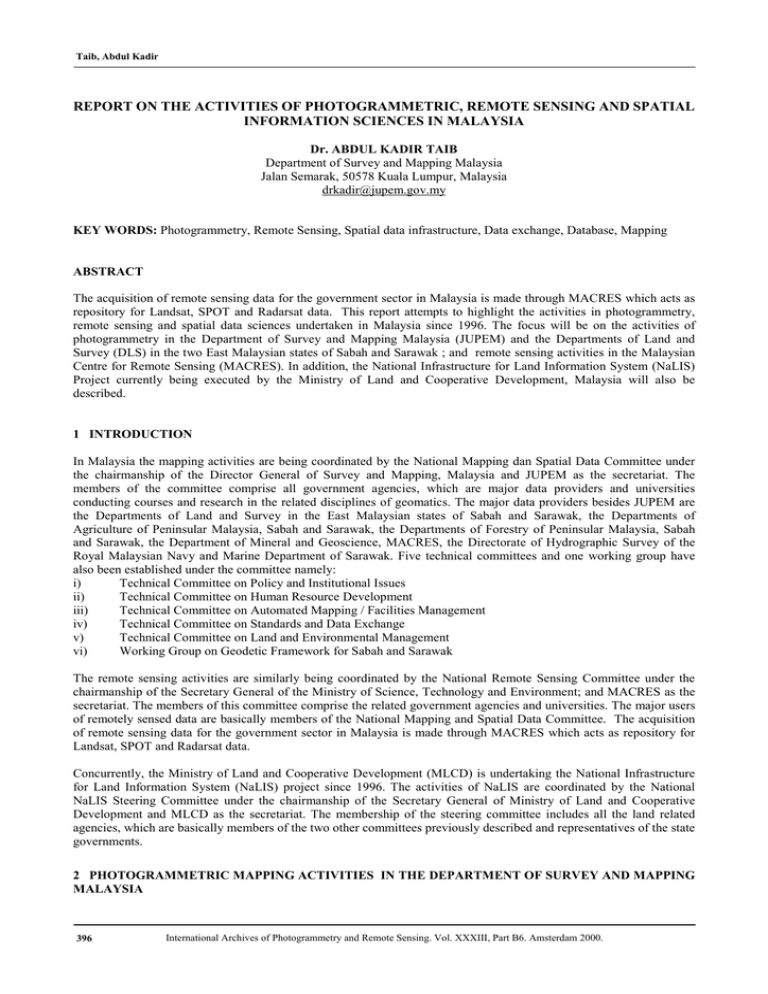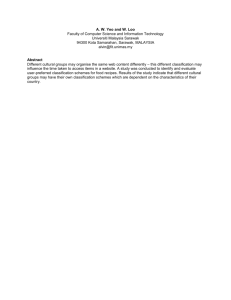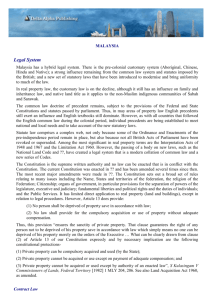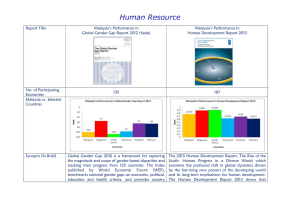REPORT ON THE ACTIVITIES OF PHOTOGRAMMETRIC, REMOTE SENSING AND SPATIAL
advertisement

Taib, Abdul Kadir REPORT ON THE ACTIVITIES OF PHOTOGRAMMETRIC, REMOTE SENSING AND SPATIAL INFORMATION SCIENCES IN MALAYSIA Dr. ABDUL KADIR TAIB Department of Survey and Mapping Malaysia Jalan Semarak, 50578 Kuala Lumpur, Malaysia drkadir@jupem.gov.my KEY WORDS: Photogrammetry, Remote Sensing, Spatial data infrastructure, Data exchange, Database, Mapping ABSTRACT The acquisition of remote sensing data for the government sector in Malaysia is made through MACRES which acts as repository for Landsat, SPOT and Radarsat data. This report attempts to highlight the activities in photogrammetry, remote sensing and spatial data sciences undertaken in Malaysia since 1996. The focus will be on the activities of photogrammetry in the Department of Survey and Mapping Malaysia (JUPEM) and the Departments of Land and Survey (DLS) in the two East Malaysian states of Sabah and Sarawak ; and remote sensing activities in the Malaysian Centre for Remote Sensing (MACRES). In addition, the National Infrastructure for Land Information System (NaLIS) Project currently being executed by the Ministry of Land and Cooperative Development, Malaysia will also be described. 1 INTRODUCTION In Malaysia the mapping activities are being coordinated by the National Mapping dan Spatial Data Committee under the chairmanship of the Director General of Survey and Mapping, Malaysia and JUPEM as the secretariat. The members of the committee comprise all government agencies, which are major data providers and universities conducting courses and research in the related disciplines of geomatics. The major data providers besides JUPEM are the Departments of Land and Survey in the East Malaysian states of Sabah and Sarawak, the Departments of Agriculture of Peninsular Malaysia, Sabah and Sarawak, the Departments of Forestry of Peninsular Malaysia, Sabah and Sarawak, the Department of Mineral and Geoscience, MACRES, the Directorate of Hydrographic Survey of the Royal Malaysian Navy and Marine Department of Sarawak. Five technical committees and one working group have also been established under the committee namely: i) Technical Committee on Policy and Institutional Issues ii) Technical Committee on Human Resource Development iii) Technical Committee on Automated Mapping / Facilities Management iv) Technical Committee on Standards and Data Exchange v) Technical Committee on Land and Environmental Management vi) Working Group on Geodetic Framework for Sabah and Sarawak The remote sensing activities are similarly being coordinated by the National Remote Sensing Committee under the chairmanship of the Secretary General of the Ministry of Science, Technology and Environment; and MACRES as the secretariat. The members of this committee comprise the related government agencies and universities. The major users of remotely sensed data are basically members of the National Mapping and Spatial Data Committee. The acquisition of remote sensing data for the government sector in Malaysia is made through MACRES which acts as repository for Landsat, SPOT and Radarsat data. Concurrently, the Ministry of Land and Cooperative Development (MLCD) is undertaking the National Infrastructure for Land Information System (NaLIS) project since 1996. The activities of NaLIS are coordinated by the National NaLIS Steering Committee under the chairmanship of the Secretary General of Ministry of Land and Cooperative Development and MLCD as the secretariat. The membership of the steering committee includes all the land related agencies, which are basically members of the two other committees previously described and representatives of the state governments. 2 PHOTOGRAMMETRIC MAPPING ACTIVITIES IN THE DEPARTMENT OF SURVEY AND MAPPING MALAYSIA 396 International Archives of Photogrammetry and Remote Sensing. Vol. XXXIII, Part B6. Amsterdam 2000. Taib, Abdul Kadir The Department of Survey and Mapping Malaysia (JUPEM), established in 1885, is the official national organisation responsible surveying and topographic mapping of Malaysia. It is a Federal Department with a workforce of more than 4000 staffs and has an annual operating budget of more than Ringgit Malaysia 70 millions. The photgrammetric mapping activities in JUPEM are primarily undertaken by the Map Production Division which is equipped with RC10, RC30 and LMK2000 aerial cameras with Computer Controlled Navigation System (CCNS); the Computer Assisted Mapping System (CAMS) and the Fast Mapping System (FMS). CAMS has been implemented with the following objectives: i) To expediate map production of the Standard National Topographic Mapping Series L7030 for Peninsular Malaysia and T738 for the states of Sabah and Sarawak at the scale of 1:50 000. ii) To facilitate the production of topographic maps at other scales and special purpose maps for civilian and military uses. iii) To create the National Topographic and Cartographic Databases at the scales of 1:25 000 and 1:50 000. Following its successful implementation, the functions of CAMS have been extended to include: i) Production of new unrestricted topographic maps at the scales of 1:25 000 and 1:50 000. ii) Production of restricted and unrestricted town maps at various scales from 1:3 000 to 1:12 500 iii) Creation of topographic and cartographic databases for towns at the scales of 1:5 000 and 1:10 000. CAMS which was commissioned in 1988 consists of the Computer Assisted Photogrammetric Subsystem (CAPS), the Computer Assisted Raster Digitising Subsystem (CARDS), and Computer Assisted Cartographic Subsystem (CACS).and the Management Information Subsystem (MIS). In order to increase its effectiveness CAMS is constantly being upgraded using development budgetory allocations under the five (5) years Malaysia Development Plan. The system is well equipped for photogrammetric compilation activities with a PUG4 point transfer device, Kern PG2 and Wild B8 stereoplotters outfitted with encoders which are in use since CAMS’ inception; and an SD2000 analytical stereoplotter and Helava stereo softcopy workstations which were procured in 1999. Likewise, the FMS commissioned in 1995, also undertakes photogrammetric mapping activities in support of CAMS and is equipped with Helava stereosoftcopy workstations and a Leica BC3 analytical stereoplotter. The system procured at the cost of Ringgit Malaysia 23.2 million also further the use of remotely sensed satellite imageries for faster data acquisition and map production. For this purpose it is additional equipped with ER Mapper image processing software. 3 PHOTOGRAMMETRIC AND REMOTE SENSING ACTIVITIES IN THE DEPARTMENT OF LAND AND SURVEY SABAH AND SARAWAK The Department of Land and Survey (DLS) is a state government department responsible for land administration, title surveying, and large scale mapping in the East Malaysian states of Sabah and Sarawak. DLS, Sabah also undertakes aerial photography of all towns for the production of large scale development plans at 1:2 500 scale. The department has implemented its Land Use Information System (LUIS), which consists of Digital Photogrammetric Subsystem and the Remote Sensing Subsystem. The later is equipped with PCI digital image processing software which is utilised for updating of Land Cover Maps at the scale 1:100 000 using remotely sensed imagery from Radarsat. In addition, the DLS, Sabah is also undertaking an IRPA research project using AIRSAR / TOPSAR data. The DLS, Sarawak undertake mapping activities which include aerial photography at the scales 1:5 000, 1:10 000, 1:20 000, 1:25 000, 1:30 000 and 1: 50 000, creation of digital photogrammetric database and production of state topographic and thematic maps in addition to the production of digital cadastral database. Among the maps produced are town maps at 1:5 000 and 1:10 000 and topographic maps at 1:25 000 and 1:125 000, map of the city of Kuching at 1:18 000 and land use maps at 1: 250 000. 4 REMOTE SENSING ACTIVITIES IN THE MALAYSIAN CENTRE FOR REMOTE SENSING (MACRES) The main activities of MACRES are research and development; acquisition and processing of remotely sensed data; and also human resource development. Its research and development projects are funded under the five years Malaysia Development Plan, Intensification of Research in Priority Areas (IRPA) programme and bilateral cooperation with international agencies. Research in areas of remote sensing by other government agencies is also being coordinated by MACRES. International Archives of Photogrammetry and Remote Sensing. Vol. XXXIII, Part B6. Amsterdam 2000. 397 Taib, Abdul Kadir The acquisition of remotely sensed data by MACRES is done on a continuous basis for the use by government agencies in Malaysia. These data include those from Landsat Thematic Mapper, SPOT and Radarsat. In order to meet the increasing demands for remote sensing data MACRES has embarked on an expansion programme which include the recruitement of additional manpower and the building of its new headquarters and a satellite ground station to receive data from Landsat, SPOT and Radarsat satellites. The civil works have been completed and the ground station facilities are in the stage of procurement. 5 NATIONAL INFRASTRUCTURE FOR LAND INFORMATION (NaLIS) The main objectives of NaLIS are to: i) Enable efficient sharing and exchange of land related information among government agencies (producers and users of land data). ii) Facilitate the development and maintenance of a land inventory for land information users. iii) Provide intelligent corporate data model for users. iv) Assist and streamline the process of landuse planning and the management of land resources. NaLIS comprises the policies, standards and prosedures of the land related agencies to produce cooperatively and to share land information. NaLIS will enable users to have on-line access to land data and with the establishment of a clearinghouse users would be able to browse through the data directory and metadata, which provides description of land data available at various agencies. Although NaLIS is still at the early stage, it nevertheless, provide a forum for various GIS/LIS related agencies and to formulate an institutional framework that will streamline the NaLIS and to avoid redundancies and other wasteful practices at a very early stage. Therefore, the successful implementation of NaLIS would ensure a smooth implementation of various land resources management and development programmes that would fuel the country towards achieving its vision of becoming a developed nation by the year 2020. 6 OTHER INITIATIVES 6.1 Development of Geographic Information Exchange Standards The establishment of new Geographic Information Exchange Standards is also being formulated through the efforts of Technical Committee 12 (TC12) under the Standard and Industrial Research Institute of Malaysia (SIRIM). It is envisaged that the efforts of this committee will facilitate the sharing and exchange of land related information among GIS users in the country. Currently, the exchange of land related data is by way of MS1074 Malaysian Standard – Code of Practice for the Exchange of Digital Feature Coded Mapping Data. This standard provides means of exchange of graphical map and chart data so that the process of spatial data exchange is simple and non-system dependent. The standard in use since 1992 is now being reviewed by TC12 in order to upgrade it to a new national geographic information exchange standard in compliance with the standards under development by the ISO/TC211. Malaysia being a P-Member of the ISO/TC211 is currently participating actively in the activities of the committee. 6.2 ISO 9001 / ISO 9002 Certification All government agencies in Malaysia are currently in the process of acquiring the ISO 9001 / ISO 9002 certification for their core products. In this regard, JUPEM has been awarded the ISO 9002 certificate for the topographic map production at the scale of 1:50 000 and town maps at the scales of 1:3 000 and 1:12 500. 7 CONCLUSION In Malaysia, the government agencies actively involved in aerial photography and photogrammetry are JUPEM, DLS Sabah and DLS Sarawak. Concurrently, all land related agencies are also actively utilising remote sensing technology in 398 International Archives of Photogrammetry and Remote Sensing. Vol. XXXIII, Part B6. Amsterdam 2000. Taib, Abdul Kadir data collection for input into their respective geographic information systems. Likewise, the complementary work of the various committees mentioned will further coordinate and facilitate the activities of photogrammetry, remote sensing and spatial information sciences in Malaysia in the future. International Archives of Photogrammetry and Remote Sensing. Vol. XXXIII, Part B6. Amsterdam 2000. 399





